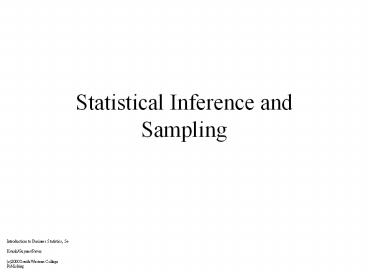Statistical Inference and Sampling - PowerPoint PPT Presentation
Title:
Statistical Inference and Sampling
Description:
Statistical Inference and Sampling Introduction to Business Statistics, 5e Kvanli/Guynes/Pavur (c)2000 South-Western College Publishing – PowerPoint PPT presentation
Number of Views:337
Avg rating:3.0/5.0
Title: Statistical Inference and Sampling
1
Statistical Inference and Sampling
Introduction to Business Statistics, 5e
Kvanli/Guynes/Pavur (c)2000 South-Western
College Publishing
2
Simple Random Sampling
- All items in the population have the same
probability of being selected. - Finite Population To be sure that a simple
random sample is obtained from a finite
population the items should be numbered from 1 to
N. - Nearly all statistical procedures require that a
random sample is obtained.
Introduction to Business Statistics, 5e
Kvanli/Guynes/Pavur (c)2000 South-Western
College Publishing
3
Estimation
- The population consists of every item of
interest. - The sample is randomly drawn from the population.
- Sample values should be selected randomly, one at
a time, from the population.
Introduction to Business Statistics, 5e
Kvanli/Guynes/Pavur (c)2000 South-Western
College Publishing
4
Random Sampling and Estimation
Introduction to Business Statistics, 5e
Kvanli/Guynes/Pavur (c)2000 South-Western
College Publishing
Figure 7.1
5
Distribution of X
- The mean of the probability distribution for X
- Standard error of X standard deviation of the
probability distribution for X
m
x
Introduction to Business Statistics, 5e
Kvanli/Guynes/Pavur (c)2000 South-Western
College Publishing
6
Distribution of X
Introduction to Business Statistics, 5e
Kvanli/Guynes/Pavur (c)2000 South-Western
College Publishing
Figure 7.6
7
Distribution of X
Introduction to Business Statistics, 5e
Kvanli/Guynes/Pavur (c)2000 South-Western
College Publishing
8
Probabilities in the Sampling Distribution of X
Figure 7.8
Introduction to Business Statistics, 5e
Kvanli/Guynes/Pavur (c)2000 South-Western
College Publishing
9
Central Limit Theorem
- When obtaining large samples from any
population, the sample mean X will follow an
approximate normal distribution. - What this means is that if you randomly sample
a large population the X distribution will be
approximately normal with a mean m and a standard
deviation (standard error) of
s
Introduction to Business Statistics, 5e
Kvanli/Guynes/Pavur (c)2000 South-Western
College Publishing
s
x
n
10
Central Limit Theorem
Introduction to Business Statistics, 5e
Kvanli/Guynes/Pavur (c)2000 South-Western
College Publishing
Figure 7.10
11
Central Limit Theorem
Introduction to Business Statistics, 5e
Kvanli/Guynes/Pavur (c)2000 South-Western
College Publishing
Figure 7.11
12
Central Limit Theorem
Introduction to Business Statistics, 5e
Kvanli/Guynes/Pavur (c)2000 South-Western
College Publishing
Figure 7.12
13
Confidence for the Mean of a Normal Population (?
known)
Introduction to Business Statistics, 5e
Kvanli/Guynes/Pavur (c)2000 South-Western
College Publishing
Figure 7.16
14
Confidence for the Mean of a Normal Population (?
known)
P(-1.96 ? Z ? 1.96)
Introduction to Business Statistics, 5e
Kvanli/Guynes/Pavur (c)2000 South-Western
College Publishing
15
Confidence for the Mean of a Normal Population (?
known)
(1-?) 100 Confidence Interval
Introduction to Business Statistics, 5e
Kvanli/Guynes/Pavur (c)2000 South-Western
College Publishing
16
Confidence for the Mean of a Normal Population (?
unknown)
- Students t Distribution
- Population variance unknown
- Degrees of freedom n - 1
Introduction to Business Statistics, 5e
Kvanli/Guynes/Pavur (c)2000 South-Western
College Publishing
17
Students t Distribution
Introduction to Business Statistics, 5e
Kvanli/Guynes/Pavur (c)2000 South-Western
College Publishing
18
Confidence for the Mean of a Normal Population (?
unknown)
X
m
t
s
/
n
Introduction to Business Statistics, 5e
Kvanli/Guynes/Pavur (c)2000 South-Western
College Publishing
19
Introduction to Business Statistics, 5e
Kvanli/Guynes/Pavur (c)2000 South-Western
College Publishing
20
Selecting Necessary Sample SizeKnown ?
- Sample size based on the level of accuracy
required for the application. - Maximum error E
- Used to determine the necessary sample size to
provide the specified level of accuracy - Specified in advance
- Equation
Introduction to Business Statistics, 5e
Kvanli/Guynes/Pavur (c)2000 South-Western
College Publishing
21
Selecting Necessary Sample SizeKnown ?
æ
ö
?
E
Z
ç
a
/
2
n
è
ø
Introduction to Business Statistics, 5e
Kvanli/Guynes/Pavur (c)2000 South-Western
College Publishing
22
Selecting Necessary Sample SizeUnknown ?
2
Z
s
é
ù
a
/
2
n
ê
ú
E
ë
û
Introduction to Business Statistics, 5e
Kvanli/Guynes/Pavur (c)2000 South-Western
College Publishing
23
Other Sampling Procedures
- Population the collection of all items about
which we are interested. - Sampling Unit a collection of elements selected
from the population. - Cluster a sampling unit that is a group of
elements from the population, such as all adults
in a particular city block . - Sampling frame a list of population elements
Introduction to Business Statistics, 5e
Kvanli/Guynes/Pavur (c)2000 South-Western
College Publishing
24
Other Sampling Procedures
- Strata are nonoverlapping subpopulations.
- Sampling design specifies the manner in which
the sampling units are to be selected.
Introduction to Business Statistics, 5e
Kvanli/Guynes/Pavur (c)2000 South-Western
College Publishing
25
Systematic Sampling
- The sampling frame consists of N records. The
sample of n is obtained by sampling every kth
record, where k is an integer approximately equal
N/n. - The sampling frame should be ordered randomly.
Introduction to Business Statistics, 5e
Kvanli/Guynes/Pavur (c)2000 South-Western
College Publishing
26
Stratified Sampling
- Stratified sampling obtains more information due
to the homogenous nature of each strata. - Stratified sampling obtains a cross section fo
the entire population. - Obtain a mean within each strata as well as an
estimate of ?.
Introduction to Business Statistics, 5e
Kvanli/Guynes/Pavur (c)2000 South-Western
College Publishing
27
Cluster Sampling
- Single-stage cluster sampling randomly select a
set of clusters for sampling. Include all
elements in the cluster in your sample. - Two-stage cluster sampling randomly select a set
of clusters for sampling. Randomly select
elements from each sampled cluster
Introduction to Business Statistics, 5e
Kvanli/Guynes/Pavur (c)2000 South-Western
College Publishing































